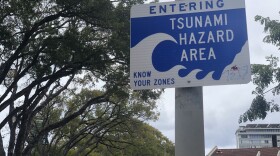Despite having an ambitious goal to plant 100,000 trees by 2025, the city has been unable to keep count of exactly how many have already been planted.
Honolulu Mayor Kirk Caldwell committed to the effort in December 2017, joining other mayors in the Chicago Climate Charter, an accord to address climate change reached by U.S. cities.
The city's Office of Climate Change, Sustainability and Resiliency website has a map where the public can both record a tree planting and view the number of planted trees. The map appears to report there have only been 193 trees planted so far.
However, Matthew Gonser, the coastal and water program manager with the resiliency office, explains that website number is unreliable.
“There was an effort last year in the fall that planted 1,000 trees in one day. We're aware of other large-scale planting like that, as well as trying to count the specific city streets and park trees,” he said. “That nearly 200 trees is definitely incorrect and significantly lower than the amount of trees that we know have been planted.”
The map on the website has only noted tree plantings by individuals who have self-reported. It hasn't taken into account information collected by the Department of Parks and Recreation and large community tree planting efforts that were not reported to the website.
Gonser said his office hopes to have more data available for the public by Arbor Day, Nov. 2.
Daniel Dinell, president of Trees for Honolulu’s Future, an organization committed to educating the public about the benefits of trees, lists tree canopies as one of the best ways to combat urban heat.
“Tree canopy is from one end of the tree to the other end of a tree,” he said, “[If you’re] driving down Kapiolani Boulevard, the monkey pod trees provide canopy cover that is close to 100%. Because if you look down from above the ground, all you see will be trees as opposed to the roadway.”
Heat reduction in the city may be more prevalent than ever with the record-breaking temperatures happening in 2019.
Between April and August of this year, Honolulu broke or tied 35 maximum heat records, according to the National Ocean and Atmospheric Administration.
Gonser links these record high temperatures to ocean warming, disruptions in trade winds and less rainfall —all of which are projected to increase with climate change.
Over the weekend, the resiliency office conducted Oahu’s first heat mapping campaign. Twenty-eight volunteers used sensors to record the temperatures and humidity in neighborhoods on the island.
Honolulu was one of 10 cities selected for the initiative, which is a partnership with NOAA, CAPA Strategies and the Science Museum of Virginia, and the National Integrated Heat Health Information System.
CAPA Strategies will use the data collected by the volunteers to create a final analysis, which Gonser hopes to receive by Thanksgiving this year.
He hypothesized that the study will show areas with low numbers of tree canopy and “high imperious surfaces,” such as concrete, will be hot spots.
Dinell said he thinks the results will help determine where trees are needed most.
“We're really looking forward to seeing the results, the analytics of that and overlaying where Honolulu is hot and where the trees are,” he said. “The map will become a really, really important part of determining the strategy of how to move forward.”




